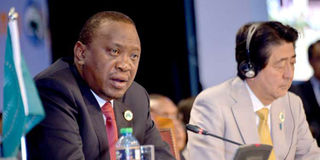Japan and Kenya sign Sh27.3bn deal to build Dongo Kundu hub

President Uhuru Kenyatta (left) and Japan's Prime Minister Shinzo Abe during a joint press conference at the close of the 6th Tokyo International Conference on African Development (Ticad) on August 28, 2016. Japan and Kenya have signed a Sh27.3bn deal to build Dongo Kundu hub. PHOTO | SALATON NJAU | NATION MEDIA GROUP
What you need to know:
- The first phase of the Special Economic Zone, which is expected to alter the coastal town in terms of infrastructure and business, is scheduled to be ready by 2019.
- The deal involves the development of infrastructure, including Berth 1 at the Port of Mombasa, access roads, transmission line, water supply pipeline from the mainland and a sub-station, drainage, power supply and a free trade zone in the zone.
- It will also entail establishment of a free trade zone on between 300 and 500 acres for wholesale and retail trading, breaking bulk, re-packaging logistics, warehousing, handling and storage of goods.
- The loan and grant facility are expected to automatically end within a period of three years.
Kenya has secured Sh27.3 billion from Japan to construct an industrial and commercial hub in Dongo Kundu, Mombasa.
The first phase of the Special Economic Zone (SEZ), which is expected to alter the coastal town in terms of infrastructure and business, is scheduled to be ready by 2019.
An agreement signed by the governments of Kenya and Japan on the sidelines of the Tokyo International Convention on Africa Development (Ticad) shows that of the Sh27.3 billion ($269.9 million), Sh21.36 billion is a long term soft loan while Sh5.969 billion is a grant.
“The Government of Japan will finance the basic infrastructure of phase one through a concessional loan of US$210.8 million and grant assistance of US$58.9 million,” the MoU says.
The industrial and commercial hub, which will sit on 1,326 hectares, is part of the master plan for the development of the Mombasa Special Economic Zone that was conceived and prepared with assistance from Japan in 2015.
The deal involves the development of infrastructure, including Berth 1 at the Port of Mombasa, access roads, transmission line, water supply pipeline from the mainland and a sub-station, drainage, power supply and a free trade zone in the zone.
It will also entail establishment of a free trade zone on between 300 and 500 acres for wholesale and retail trading, breaking bulk, re-packaging logistics, warehousing, handling and storage of goods.
LARGEST EXPORT DESTINATION
The area will be reserved for re-exports to the 400 million-people Common Market for Eastern and Southern African (Comesa), allowing trans-shipment of cargo without inspection or customs duty.
The Comesa bloc is the single largest export destination for Kenyan goods, accounting for 35 per cent of the Sh517.9 billion worth exported in 2012.
The 17.5 kilometre Dongo Kundu bypass, which starts from Miritini, aims to link Mombasa mainland west to mainland south without passing through the island. It is already under construction.
The MoU says Kenya and Japan will “work together to create new employment during phase one consisting of 6,800 direct jobs and to ensure that the works are accelerated and consider all measures to achieve the target of completion of phase one in 2019.”
The loan and grant facility are expected to automatically end within a period of three years.
To expedite the development of the industrial and commercial hub, the two countries agreed to establish the Mombasa (Dongo Kundu) SEZ Development Agency that will oversee construction work.
Within a month, the Office of the President and the Japanese Ministry of Foreign Affairs will form a joint committee co-chaired by Chief of Staff and Head of Public Service Joseph Kinyua and Japan’s ambassador in the country, Mr Tatsushi Terada.
“This committee will oversee the implementation of the areas of cooperation identified under this MoU,” the document says.
Cabinet approved the master plan for the development of the Dongo Kundu Sez in February this year.
However, the process of securing funding took long, forcing the government to delay the ground breaking ceremony.




